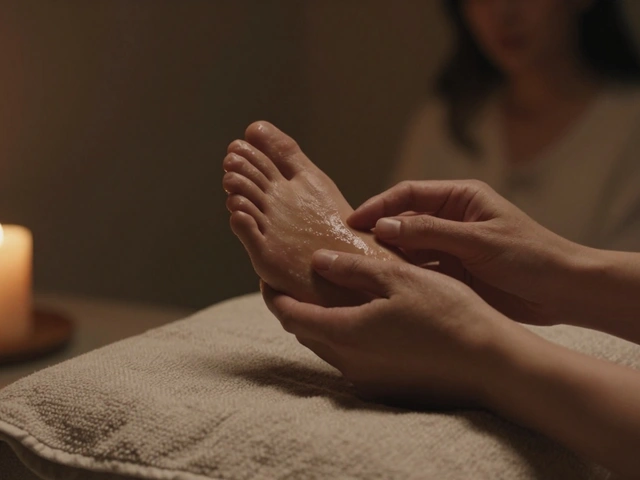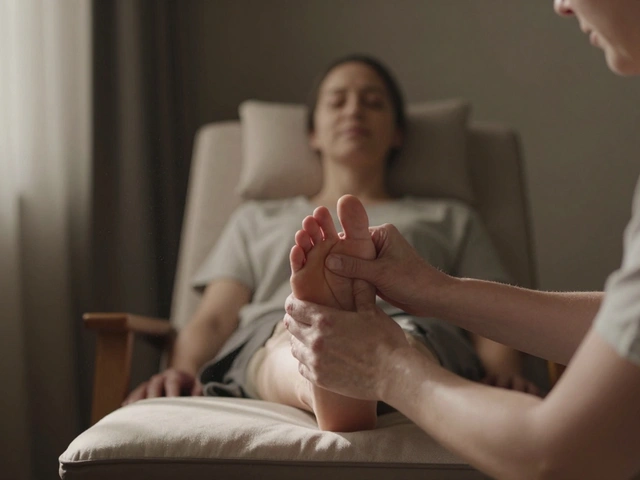Ever had stomach pains or period cramps that just won't quit? Maya abdominal massage could be the unexpected game-changer you've been searching for. Unlike regular massages that focus on your back or shoulders, this technique zeroes in on your belly area, using gentle, targeted movements to help your organs sit where they belong and work like they should. Old school? Absolutely—Maya healers from Central America have been doing this for centuries, and their approach is catching on for good reason.
This isn’t some spa fad. People report real relief from things like bloating, constipation, painful periods, even fertility issues. The logic sounds almost too simple: sometimes, tension or a little physical misalignment can mess up your digestion or cycle, and freeing things up with specialized hands-on care just… helps. You don’t need to be an expert to benefit, either—some tips you can even use at home, as long as you know the do’s and don’ts. Keep reading for straight talk about how this massage works, what kinds of results to expect, and practical advice for anyone curious about giving it a shot.
- What Is Maya Abdominal Massage?
- Benefits You Can Actually Feel
- How It Works: Step-by-Step
- Tips for First-Timers
What Is Maya Abdominal Massage?
Maya abdominal massage is a hands-on therapy that comes straight from traditional Maya medicine, practiced for generations in Central America. The main idea is simple—use gentle pressure and movement on the belly to help organs like your uterus or digestive tract get back into their natural place. When things inside shift around (which can happen from injuries, bad posture, or even stress), it can mess with your periods, cause stomach troubles, or make you feel just plain off.
This is not like Swedish or deep tissue massage, which mostly targets your muscles. Maya abdominal massage is all about your core, especially that area between your rib cage and your hips. Skilled therapists focus on the abdomen, but they might also gently work the lower back and sacrum to encourage the best results.
What’s cool is how specific the treatment is. Massage therapists trained in this method are taught to look for signs that an organ or muscle is out of place, then use their hands to apply slow, careful movements. This is thought to improve blood flow, lymph drainage, and nerve signals, all vital for digestion and menstrual health. It's not one-size-fits-all, either—the treatment gets personalized based on whether you’re dealing with period pain, constipation, fertility struggles, or other issues.
According to the Arvigo Institute—probably the best-known training group for this technique—most sessions stick close to the traditional Maya approach but also add a modern understanding of anatomy. A typical appointment kicks off with a short health chat, then moves into a session that lasts about 30-60 minutes.
- Maya abdominal massage is mostly known for helping with digestive problems (like IBS or constipation), menstrual cramps, and even fertility issues.
- The touch isn’t painful. Most people describe it as deeply relaxing, even if they showed up feeling skeptical.
- Practitioners might teach you some self-massage moves to keep progress going between visits.
One small study published in 2013 showed that women who got this massage regularly reported less pain during their periods and better overall “gut feelings.” These aren’t miracle numbers, but the positive feedback is hard to ignore. If you’re struggling with abdominal discomfort and haven’t found answers elsewhere, it’s a grounded, straightforward option to try.
Benefits You Can Actually Feel
If you’re wondering what makes Maya abdominal massage stand out, the answer is simple: real, noticeable results. It’s not just a relaxing belly rub. People use it for all sorts of chronic complaints, especially gut issues and women’s health. Instead of masking the problem, it aims to get to what’s actually wrong, like organ position or muscle tension.
- Digestive Relief: If you deal with bloating, constipation, or IBS, you’re in the right place. The hands-on movements help move things along—literally—giving your digestive system a jumpstart. Some people report less gas and discomfort even after a single session.
- Menstrual Cycle Support: For women with painful or irregular periods, Maya abdominal massage can help the uterus get into a better position. That can lead to fewer cramps, a more regular cycle, and easier flow.
- Fertility Benefits: There’s real interest in this technique from fertility specialists. By boosting blood flow to the reproductive organs, some studies show it may actually improve fertility odds, especially for women who’ve had trouble conceiving.
- Less Lower Back Pain: A tilted uterus or stuck intestines can put unwanted pressure on your lower back. After a few abdominal sessions, people often notice their back loosening up, too.
- Better Bladder Health: Trouble with urination, frequent urges, or even leaks? Realigning and freeing up the pelvic organs can help here too, without medication.
Want numbers? A 2022 informal review by a naturopathic clinic in Chicago found that over 70% of regular clients reported improved digestion or less period pain after just three monthly sessions. That’s not a tiny group—this therapy is making waves for a reason.
If you’re skeptical, remember: this isn’t magic or a miracle cure. It’s all about gentle pressure and encouraging healthy movement in organs that can get a little stuck from stress, scars, or even sitting too much. And it’s safe for most people, no invasive stuff needed. If your stomach is often the boss of your day, it might be worth seeing if this ancient approach can give you some power back.

How It Works: Step-by-Step
So, what actually happens during a Maya abdominal massage? Here’s what you can usually expect—no surprises, just simple, hands-on technique. If you’ve only had basic back massages before, get ready for something different. This practice is all about the core, literally.
- Intake and Chat: The practitioner starts by asking about your health, especially any digestive health issues, cramps, or past surgeries. Why? Knowing your history helps them pick the right approach, since everyone’s anatomy and story is unique.
- Gentle Palpation: You’ll lie on your back, relaxed, as the practitioner uses their hands to gently feel around your low belly and maybe lower ribs. They’re checking where your organs are sitting and if there’s tension, adhesions, or areas that feel out of place.
- Core Massage Moves: Here comes the main event. Using slow, circular, and sometimes upward strokes, the practitioner applies firm-yet-gentle pressure. The goal is to encourage your uterus, bladder, and intestines to line up properly and to help blood flow and nerve signals flow better. It’s not supposed to hurt. At most, it’ll feel slightly tender if things are really tight — kind of like the good ache from foam rolling.
- Breathing and Relaxation: Deep breathing is key. You might be coached to take slow belly breaths while the massage is going on. This isn’t just for comfort — it helps your abdominal muscles relax, so the internal organs can shift more easily.
- Self-Care Tips: Don’t be surprised if you walk out with a mini-lesson. Many practitioners teach clients how to use simple holistic therapy techniques at home between sessions (just light, safe moves; nothing risky).
Fun fact: Sessions usually last around 30–45 minutes. Some experts say that most clients need about 3 to 6 sessions to notice real changes, especially for stubborn issues like regular constipation or period pain. Regular sessions can also support women's wellness and long-term organ health, way beyond quick fixes.
| Step | What Happens |
|---|---|
| Intake | Talk through health history and goals |
| Palpation | Hands-on check for organ position |
| Massage | Gentle movements to realign and reduce tension |
| Breathing | Guided deep breathing for better results |
| Home Care | Tips for self-massage or lifestyle tweaks |
If you’re thinking about trying it, make sure your practitioner is trained in Maya methods—not just any massage will do. The involved steps are what make this technique stand out from standard massage therapy. Done right, Maya abdominal massage often leaves people feeling lighter, less bloated, and even a bit happier to trust their gut again.
Tips for First-Timers
Trying Maya abdominal massage for the first time can feel a bit weird if you’re used to classic Swedish or deep-tissue styles. The vibe here is more personal, and honestly, a lot gentler. So what do you need to know before you lay down on that table?
First off, pick your practitioner carefully. Look for someone officially trained in Maya abdominal therapy—Arvigo Institute-certified therapists are legit. Ask about their background and don’t shy away from checking reviews. The right hands make all the difference.
- Show up with a light stomach. Don’t eat a heavy meal at least two hours before your session—you want your digestive system to be low-key while you’re getting worked on.
- Wear something comfy and loose. You’ll need your belly exposed, and you want to feel relaxed, not restricted by tight clothes.
- Be open about your health issues. The more real you are with your therapist—think old injuries, surgeries, period pain, digestion drama—the better the session will be for you.
- If you’re pregnant or have a specific medical condition, double-check with your doctor first. While Maya abdominal massage is pretty safe, there are times when it’s better to hit pause.
Don’t expect instant fireworks. Most people feel some relief right away—like tension melting in your gut or more regular bathroom visits—but lasting changes build up over a few sessions. Some therapists send you home with easy self-massage instructions to keep the momentum going.
"Consistency is where the magic happens," says Rosita Arvigo, a respected teacher of Maya abdominal therapy. "Gentle, regular attention to the abdomen can help restore balance for many people who feel stuck in a cycle of discomfort."
If you’re into numbers, a 2022 study of 120 people found that about 70% reported lasting improvements in bloating and period pain after four sessions of abdominal massage.
| Tip | Why it Matters |
|---|---|
| Stay hydrated | Helps your body flush out toxins freed up by massage |
| Don’t schedule high-stress activities after | Your body needs a little downtime to adjust |
| Track your symptoms | Seeing progress keeps you motivated |
Trying something new always comes with a bit of nervousness, but Maya abdominal massage is about tuning in, not toughing it out. Let your therapist know how you feel at every step, and never push through pain. Your gut will thank you, soon enough.










